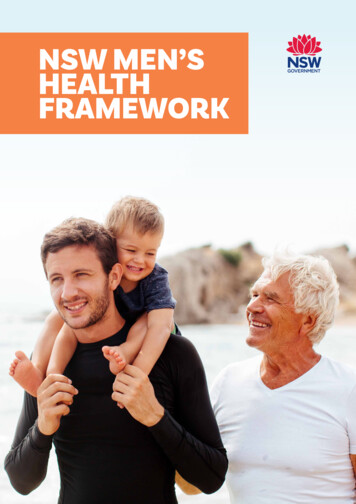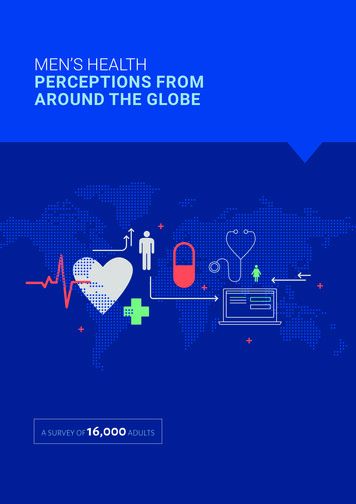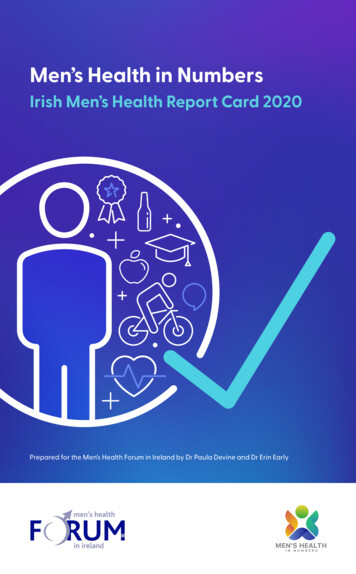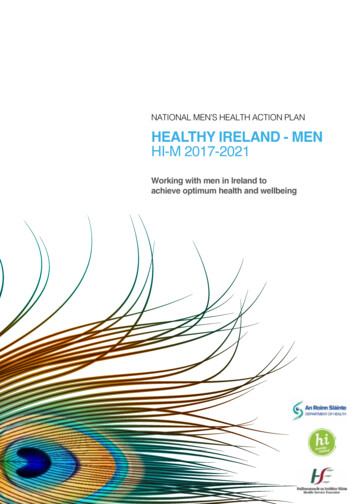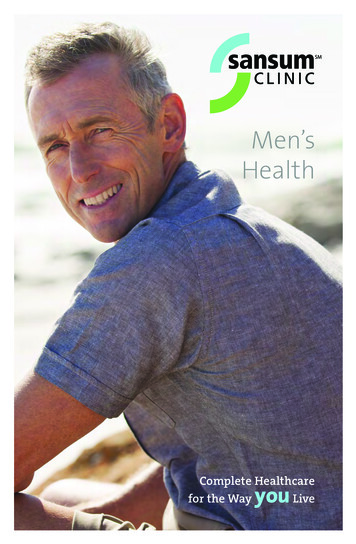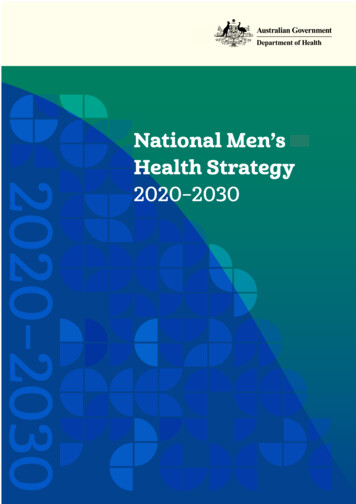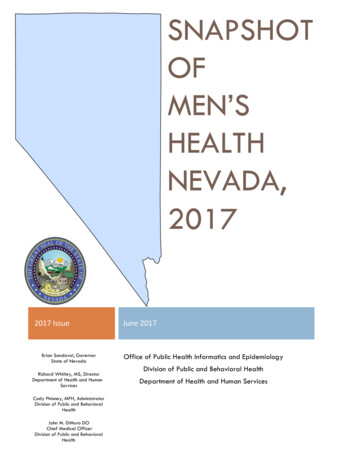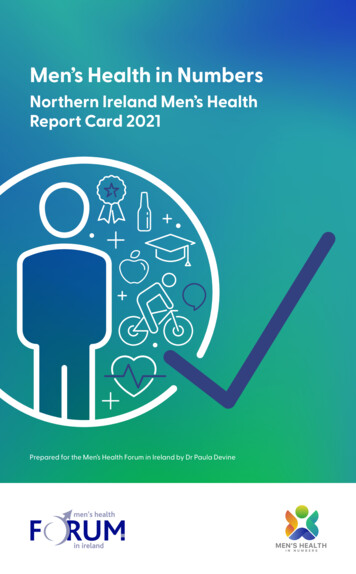
Transcription
Men’s Health in NumbersNorthern Ireland Men’s HealthReport Card 2021Prepared for the Men’s Health Forum in Ireland by Dr Paula DevineMEN’S HEALTHINNU MBERS
THANKS AND ACKNOWLEDGEMENTSThe production of this report was only possible because of thegenerosity, goodwill, support, advice and practical assistanceoffered by a broad range of individuals and organisations.The Men’s Health Forum in Ireland (MHFI) would like to give special mention to: Belfast Health and Social Care Trust Carers’ Support Service - for funding thispublication [the Carers’ Support Service can be contacted at Tel: 028 9504 2126Email: CarerSuppSvcs@belfasttrust.hscni.net]. Health Service Executive (HSE) Health and Wellbeing – for providing the fundingto undertake the initial data gathering process for the Men’s Health in Numbersinitiative. The researcher / report author – Dr Paula Devine from ARK (www.ark.ac.uk) withinQueen’s University Belfast (QUB). Prof Derek Griffith, from Vanderbilt University, USA, who generously shared hisexperience of developing the Tennessee Men’s Health Report Card with us. Thiswas the inspiration behind our Men’s Health in Numbers publications. All of the people who contributed to the Advisory Group for this initiative:· Prof Kevin Balanda: Public Health Researcher· Colin Fowler: Men’s Health Forum in Ireland· Fergal Fox: HSE Health and Wellbeing· Dr Karen Galway: School of Nursing and Midwifery, QUB· Finian Murray: HSE Health and Wellbeing· Shane O’Donnell: Marie-Curie Early Stage Researcher· Biddy O’Neill: Department of Health, Republic of Ireland· Dr Gillian Prue: School of Nursing and Midwifery, QUB· Dr Noel Richardson: National Centre for Men’s Health, IT CarlowMEN’S HEALTHI Nmen's healthN U M B E R SARKRUMin irelandCITATIONDevine, P. (2021), Men’s Health in Numbers: Northern Ireland Men’s Health Report Card 2021.Dublin: Men’s Health Forum in Ireland.This report is available online at: www.mhfi.org/MensHealthInNumbers3.pdf2
IntroductionThe Men’s Health Forum in Ireland (MHFI) is a diverse network of individualsand organisations, men and women, from both Northern Ireland and theRepublic of Ireland. The Forum was established in 1999, and operates on anall-island basis.MHFI was established in response to the growing recognition of the need to address the poor healthstatus of males in Ireland. However, one of the first challenges facing it was to gain access to reliabledata upon which to plan future interventions. This remains an ongoing concern - as the Forum seeks towork in an evidence informed way.This barrier was, initially, overcome when MHFI launched its seminal Men’s Health in Ireland report inJanuary 2004 (www.mhfi.org/fullreport.pdf). This document provided the most comprehensive overviewof key statistics on men’s health on the island of Ireland ever collated up to that time. It offered clearevidence of local males’ health needs, and a roadmap for action. Importantly, it also provided a baselineagainst which to measure progress in the future.To mark its twenty-first birthday in 2020, the Forum undertook an initiative titled Men’s Health in Numbers.Funded by the Health Service Executive (HSE) Health and Wellbeing, this sought to produce:1. A comprehensive Trends Report that describes changes in significant markers of men’s health on theisland of Ireland between 2004 and 2019.2. An Irish Men’s Health Report Card that provides a contemporary synopsis of key men’s health statisticsin the Republic of Ireland.In early 2021, with financial support from the Belfast Health and Social Care Trust Carers’ Support Service,work began on researching and producing a Northern Ireland version of the Report Card i.e. this document.The amount of data available on the health of men and boys on the island of Ireland is almost endless.This Report Card can only give a flavour of some of the important issues in the lives of local males. Itfocuses upon headline statistics and, for simplicity, presents most of these as infographics. If you wouldlike to explore more detailed data, please have a look at the substantive Men’s Health in Numbers:Trends on the Island of Ireland report which is available at: , check-out some of the data sources on page 19 of this Report Card.A lot has changed in Ireland - and the world - since our Men’s Health in Ireland report was publishedin 2004. Indeed, even at the deadline for publication of this Report Card, the range of data availableto us is constantly evolving and changing. COVID-19 is also having a dramatic impact upon the healthand wellbeing of everyone and, no doubt, will have a long-lasting legacy. Thus, this Report Card onlyrepresents a snapshot taken at one particular period in time, and - if we were able to wait until 2022 - wemight also be able to draw upon data from the 2021 Census in Northern Ireland.The figures in this booklet provide some cause for optimism, alongwith some grounds for concern. The four main causes of deathamong males in Northern Ireland continue to be neoplasms, circulatorysystem diseases, respiratory system diseases, and external causesof injury and poisoning. That said, it is important to note that deathrates from these have often been reduced due to factors such asthe adoption of healthier lifestyles, the uptake of screeningprogrammes, better diagnostic tools, improvements in healthliteracy and help-seeking behaviours, availability of supportservices, and more effective treatment options.The figures in thisbooklet providesome cause foroptimism, alongwith some groundsfor concern.3
This progress, combined with the fact that Northern Irish males now live longer, means that the overallpopulation of males is ageing. The downside, though, is that we can expect a higher incidence of somecancers and chronic conditions in the future.Yet, excessive alcohol use remains high. Too many males are overweight. The number of males diagnosedwith gonorrhoea has increased. Many boys under-achieve in education. The prevalence of autism isincreasing . However, the mortality rate for all invasive cancers (excluding NMSC) has fallen and thesurvival rate has increased. There are fewer male smokers. The number of male suicides has fallen. Theproportion of male deaths due to diseases of the circulatory system has decreased. The number of malesdiagnosed with HIV has declined. Healthy life expectancy for males has increased But Northern Irish males are not a homogenous group, and there are significant differences in thecircumstances of their lives, health behaviours and health outcomes. Indeed, it is worrying that incidencerates of diseases and chronic conditions are, mostly, higher within areas of deprivation.It is worrying thatincidence ratesof diseases andchronic conditionsare, mostly, higherwithin areas ofdeprivation.Not too long ago, we were unaware of the full extent of men’s poorhealth status and the specific health issues that they are contendingwith. However, this is no longer the case. In recent years, a broad rangeof research has highlighted the health challenges which face men on theisland of Ireland and further afield. Yet, although the health of local mencan, sometimes, be poor, it is not a ‘lost cause’. It can be improved in manysignificant ways. Indeed, a wide range of innovative and pioneeringinitiatives have already been developed to support the health needs ofmen and boys. Some examples of these are peppered throughout thisReport Card.Much has already been achieved but, as they often say in Report Cards:‘there is still room for improvement’. Males, themselves, need to play acentral role in taking control of their health and wellbeing. However, malehealth is not just an issue for individual men and boys; their health can oftenbe determined and influenced by other policy, economic, environmental,educational and social factors which are outside of their personal control.This dynamic is represented in the ‘Health Impact Pyramid’ towards theend of this booklet on page 18. Thus, there is also a role in improving malehealth for decision-makers, service providers and society as a whole.Northern Irelanddoesn’t have adedicated policy,strategy or actionplan to improvemen’s health andwellbeing.Male health is not justan issue for individualmen and boys. It canbe determined andinfluenced by factorswhich are outside oftheir personal control.The Republic of Ireland was the first country in the world to adopt aNational Men’s Health Policy and, subsequently, a Healthy Ireland - MenAction Plan. However, to date, Northern Ireland hasn’t developed its owndedicated policy, strategy or action plan to improve men’s health andwellbeing.We hope that these materials will be a practical resource for manyorganisations across the island of Ireland - by highlighting some of the mainareas for concern, providing evidence of need, mapping the magnitudeof the work which needs to be undertaken, and inspiring practical andrealistic responses.The Men’s Health Forum in Ireland4
PopulationTOTAL POPULATIONAREA OF RESIDENCEPOPULATION OF NORTHERNIRELAND IN 2019: 1,893,667MALES: 932,717 (49.3%)(2019)BIRTHSIN 201911,666 males(52%)10,781 females(48%)Source: Registrar General Annual Report 2019AGE PROFILEMALES HAVE AYOUNGER AGE PROFILETHAN FEMALESLocal GovernmentDistrictAGE .9%5.0%75-846.0%Source: NISRA Mid-Year Population Estimates 2019AGEING: OLDER MALESAGE80 % of malepopulationAntrim andNewtownabbey70.08Ards and North Down78.58Armagh City, Banbridgeand Craigavon107.512Belfast167.018Causeway Coast and Glens71.78Derry City and Strabane74.48Fermanagh and Omagh58.86Lisburn and Castlereagh71.78Mid and East Antrim68.47Mid Ulster74.78Newry, Mourne and Down90.0109.2%1.4% 85 2.6%AGE70 000s2018: 95,695 (10.3%)2048: 174,962 (17.6%)2018: 30,535 (3.3%)Source: NISRA Mid-Year Population Estimates 20192048: 79,452 (8.0%)CASE STUDYAGE90 2018: 3,857 (0.4%)2048: 14,058 (1.4%)THE NUMBER OF OLDERMEN IS EXPECTED TO RISEOVER THE NEXT 30 YEARSSource: NISRA 2018-based Population Projections‘Challenges and Choices’ Man ManualThe ‘Challenges and Choices’ Man Manual is a freebooklet which highlights ten key men’s health issues. Itthen: issues a realistic and practical challenge to improvethe reader’s health in each area of concern; provides areason for why it is important to consider taking action;offers three possible choices for what actions can betaken; signposts the reader to local sources of help andsupport.www.mhfi.org/challenges2021.pdf5
LIFE EXPECTANCYLife Expectancy at BirthLIFE EXPECTANCYAT BIRTH FOR MALESHAS INCREASEDOVER MALE2017-19 Life Expectancy at Birth by Area of LE74.779.6FEMALEBUT THOSE IN THEMOST DEPRIVED AREASHAVE SHORTER LIVES81.684.5FEMALEHealthy Life ExpectancyHEALTHY LIFEEXPECTANCYFOR MALES LEFEMALE61.0Source: Life Expectancy in Northern Ireland 2017-19 (Department of Health)HOMELESSNESS5,635single males presentedas homeless in 2019-20Source: Northern Ireland Housing Statistics 2019-2020 (Department for Communities)6
Family andRelationshipsRELATIONSHIPS orcesAverage age ofmales: 35.4 years(Female: 33.4 years)5 male partnershipsdissolved(7 female)4657Male civilpartnershipsFemale civilpartnershipsAverage age ofmales: 37.9 yearsAverage age offemales: 37.0 yearsSource: Registrar General Annual Report 2019LONE FATHERS5,639males were loneparents in 2011(9% of alllone parenthouseholds)In 2018/19:men had a10% ofcaringresponsibility4% of men aged 16-2417% of men aged 45-549% of men aged 75 Source: Health Survey Northern IrelandCHILDPROTECTIONOn 31 March 2020:12,456boys were known to Social Servicesas a child in need (9,958 girls)1,220boys were on the ChildProtection Register (1,078 girls)1,815boys were in care (1,568 girls )Source: Children’s Social Care Statistics for NorthernIreland 2019/20 (Department of Health)Source: NISRA Census Table KS107NICASE STUDYEngageThe Engage Men’s Health Training Programme wasdeveloped to assist practitioners to build effectiverelationships with males of all ages in order to addresstheir health and wellbeing needs. Engage offers serviceproviders a range of focused one day experiential andinteractive workshops, that increase their understandingof the world of men, and help them to develop strategiesfor making realistic connections. There is a team of Engagefacilitators in the WHSCT area.www.mhfi.org/training.htmlLONELINESSIn 2019/20:men showed20% ofsignsof loneliness16% of men aged 75 24% of men aged 55-64Source: Health Survey Northern Ireland7
Educationand WorkEDUCATIONAL EXPERIENCESCHOOL ATTENDANCETHIRD LEVEL QUALIFICATION55%40.4%of all 16-17 yearold boys arestudying A levelsor equivalentin schools(72% of all girls)of all students fromNorthern Ireland gaininga higher educationqualification at a UKHigher EducationInstitute were malein 2018/19Source: Annual Enrolments at Schools and inFunded Pre-School Education in Northern Ireland2020/21 (Department of Education)Source: Qualifications Gained at UK Higher Education Institutions:Northern Ireland Analysis 2018/19 (Department for the Economy)YOUNG MALES WHO ARE NOT IN EMPLOYMENT,EDUCATION OR TRAINING (NEET): % OF 16-24 YR OLDSBEFORE COVID,THERE WAS A FALL INTHE PROPORTION OFYOUNG MALES WHO ARENOT IN EMPLOYMENT,EDUCATION ORTRAINING (NEET)JAN-MAR2013JAN-MAR202016.6%NORTHERN IRELAND12.8%UKNORTHERN IRELANDUK9.8%10.7%Source: Northern Ireland Labour Force Survey (NI), Office for National Statistics (UK)EARNINGS (FULL-TIME)MEDIAN FULL-TIME GROSSANNUAL EARNINGS 2020: 29,862MALEEMPLOYEES 26,149FEMALEEMPLOYEESThis means that half of all males earnedabove 29,862 and half earned below 29,862MEDIAN HOURLY EARNINGS(EXCL OVERTIME) FULL-TIME: 12.82MALES8 13.28FEMALESHOURS WORKED87% 57%of malesworkedfull-timeof femalesworkedfull-timeSource: Annual Survey of Hours and Earnings 2020CASE STUDYSheds for LifeSheds for Life is a community-based health promotionprogramme aimed at supporting local members of IrishMen's Sheds. The programme seeks to facilitate open andmeaningful health-focused discussions, while encouragingmen to adopt and maintain healthier lifestyle choices, andto increase their awareness in areas such as physical activity,healthy eating and mental wellbeing.https://menssheds.ie/sheds-for-life
EMPLOYMENT RATESTHETHE MALEMALEUNEMPLOYMENTUNEMPLOYMENTRATERATE HASHAS FALLENFALLENSINCESINCE 200920092009:8.4%2019:2.7%TheThe COVIDCOVID pandemicpandemic hashas hadhad aa hugehugeimpactontheeconomy.Thismeansimpact on the economy. This means thatthatfuturefuture employmentemployment andand unemploymentunemploymentfiguresfigures will,will, mostmost likely,likely, bebe veryvery different.different.HOWEVER,HOWEVER, ITIT ISIS LIKELYLIKELYTHATTHAT COVIDCOVID WILLWILL HAVEHAVE AAHUGEHUGE IMPACTIMPACT ONON MALEMALEEMPLOYMENTEMPLOYMENTMALEMALE EMPLOYMENTEMPLOYMENT RATERATE ININ NORTHERNNORTHERN IRELANDIRELAND(%(% OFOF 16-6416-64 AGEAGE RA)(NISRA)OCCUPATION GROUPSOctoberOctober 20192019 -- SeptemberSeptember 20202020%Number% ofof workersworkersNumber ofofmaleswho areare malemalemales (000s)(000s) whoSkilledSkilled tradestrades ess, plantplant andand machinemachine ers, directorsdirectors andand seniorsenior te professionalprofessional andand technicaltechnical ementary Professional occupationsoccupations84.684.645.945.9SalesSales andand customercustomer serviceservice veAdministrative andand secretarialsecretarial g, leisureleisure andand otherother serviceservice nualPopulationPopulationSurveySurvey9
Healthand LifestyleSELF-REPORTEDHEALTHPHYSICALACTIVITYIn 2019/20:61%72% of males rated theirhealth as good or very good88% of males aged 16-24 ratedtheir health as good or very good50% of males aged 75 rated theirhealth as good or very goodof men met the physical activityrecommendation of at least 150minutes of physical exercise perweek in 2016/17LONG-TERM CONDITION41%38%of males aged 16 hadphysical or mental healthconditions or illnesseslasting or expected tolast 12 months or morein 2019/20WEIGHTIn 2019/20, ofmales aged 16 NUTRITIONof men consumed5 or more portionsof fruit andvegetables perday in 2019/202% 1%28%26%43%1%28%43%26%2%underweightnormal weightoverweightobesemorbidly obeseIN 2019/20, 5% OF 2-15 YEAR OLDS,35% OF 45-54 YEAR OLDS AND 38%OF 65-74 YEAR OLDS WERE OBESESource: Health Survey Northern Ireland10
SMOKING% of men who smoke cigarettes2010/11: 25%2019/20: 18%THE NUMBER OF MALESMOKERS HAS FALLENSINCE 2010/117% of men use e-cigarettesSource: Health Survey Northern IrelandALCOHOL AND DRUG USEIn 2019/20:80% of men drank alcohol26% of men drank above recommended weekly limitsIn 2019:Source: Health Survey Northern Irelandwere treated for problem4,470 malesalcohol or drug usepeople being treated for problem66% ofalcoholand drug use were maleSource: Census of Drug and Alcohol Treatment Services in Northern Ireland: 30th April 2019LIFE SATISFACTIONIn 2018/19:88%of men were verysatisfied or satisfiedwith life4%MENTAL HEALTHA high score on the GHQ-12 scaleindicates a possible mental healthproblem.18%of men hada high GHQ-12score in 2019/20of men weredissatisfied or verydissatisfied with life10% of men aged 65-7426% of men aged 25-34Source: Health Survey Northern IrelandSource: Health Survey Northern Ireland11
Causeof DeathAverage age at death in 2019:MALES: 74.2 YEARSFEMALES: 79.4 YEARSLEADING CAUSES OF DEATHFOR MEN IN N. IRELAND (2019)7.7%LEADING CAUSES OF DEATHFOR 0-14 YEAR OLD MALESTOTALDEATHS30.1%Diseases of thecirculatory system7,790Respiratory diseases24.6%External causes ofinjury and poisoningCertain conditions originatingin the perinatal period4% 4%Malignant neoplasms5.3%12.2%CANCER IS NOW THE LEADINGCAUSE OF DEATH FOR MALESTOTALDEATHS30.4%52.8%Malignant neoplasms125AccidentsCongenital malformationsand chromosomal abnormalitiesExternal causes of injury andpoisoning (including accidents,suicide and intentional self-harm)EXTERNAL CAUSES OF INJURY AND POISIONING (INCLUDING ACCIDENTS,SUICIDE AND INTENTIONAL SELF-HARM) IS THE LEADING CAUSE OF DEATHFOR 15-54 YEAR OLD MALESLEADING CAUSES OF DEATHFOR 15-34 YEAR OLD MALESExternal causes of injuryand poisoning (includingaccidents, suicide andintentional self-harm)5.2%5.6%6.1%8%TOTALDEATHSDiseases of thecirculatory systemLEADING CAUSES OF DEATHFOR 55-74 YEAR OLD MALES24.2%Diseases of thecirculatory system40.6%External causes of injuryand poisoningSource: Registrar General Annual Report 20191222.2%External causes of injury andpoisoning (including accidents,suicide and intentional self-harm)Malignant neoplasmsDiseases of the circulatory system617Diseases of the digestive system22.5%Diseases of the respiratory systemLEADING CAUSES OF DEATHFOR 75 YEAR OLD MALES7.4%Malignant neoplasms9.7%Diseases of therespiratory systemDiseases of thedigestive system25.9%TOTALDEATHSMalignant neoplasms4.5%7.2%2,30711.8%Diseases of thenervous system75.1%TOTALDEATHS4.9%Malignant neoplasms21310.7%LEADING CAUSES OF DEATHFOR 35-54 YEAR OLD MALES14.7%TOTALDEATHS4,57627.3%Diseases of the circulatory systemDiseases of the respiratory systemMental and behavioural disordersDiseases of the nervous system26.4%CANCER IS THE LEADING CAUSEOF DEATH FOR MALES AGED 55
1010 YEARYEAR TRENDS:TRENDS: LEADINGLEADING CAUSESCAUSES OFOF MALEMALE atrepeathealthhealthcheckcheckatat5252weeks.weeks. ROAD FATALITIESFATALITIESROAD37SUICIDESUICIDEmalesmales dieddied inin transporttransportaccidentsaccidents inin 2009: 2052019: sALCOHOL RELATEDRELATED EATHSDEATHSSPECIFIC2001: 1172019: a/community-and-health/healthy-club13
MalesMalesandand cancercancer(NMSC):(NMSC):1994:1994:3,0973,097 ng:developing:1 in1 in221 in1 in441 in1 in7 71 in1 in11111 in1 in12121 in1 in17171 in1 in33331 in1 in35351 in1 in40401 in1 in45451 in1 in46461 in1 in52521 in1 in53531 in1 in56561 in1 in81811 in1 in83831 in1 in96961 in1 in1871871 in1 portServiceServiceBHSCT’BHSCT’s Carers’s llallcarerscarers- including- ernationalInternationalMen’Men’s Healths HealthWeekWeek- held- heldininJuneJuneeacheachyearyear- offers- 021,90 90 rce:RegistrarGeneralCauseofofDeathTables2019
5485casescases casescases INTHETHELEASTLEASTDEPRIVEDDEPRIVEDAREASAREAS15
ALLENFALLENISCHAEMICISCHAEMIC HEARTHEART DISEASEDISEASE2009:2009: 145145 perper 100,000100,0002019:2019: 107107 perper %ofofmalemaledeathsdeaths14.5%ofofdea
1. A comprehensive Trends Report that describes changes in significant markers of men’s health on the island of Ireland between 2004 and 2019. 2. An Irish Men’s Health Report Card that provides a contemporary synopsis of key men


